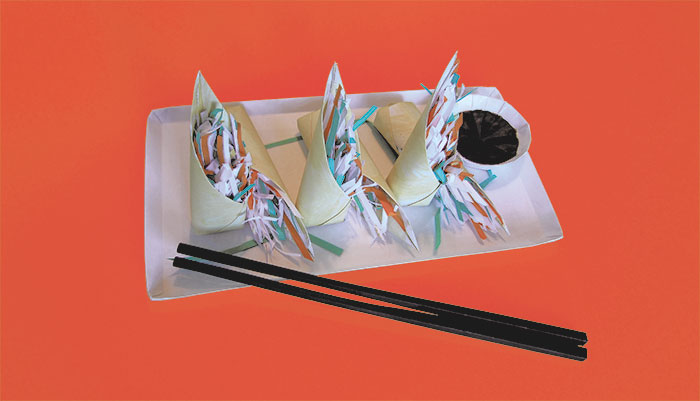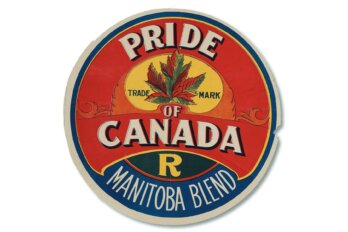Bao Bei, a self-styled Chinese brasserie, opened last year in a corner of Vancouver’s Chinatown that’s typically deserted after 6 p.m. But on this weekday night, it’s jammed with thirtysomethings in hip eyewear, eating and drinking under consommé-hued lighting to a soundtrack that veers from Guns N’ Roses to contemporary indie rock. Bao Bei, which means “precious” in Mandarin, plays off the centrality of the meat-filled bun or dumpling, the bao, in Chinese cuisine. The place has an air of informality (it doesn’t take reservations), which is also reflected in its mix-and-match decor: vintage ceramic chinoiserie and framed family portraits, including an enlarged black and white photo of owner Tannis Ling’s father at a high school dance in Hong Kong.
If one were to judge Bao Bei by the most common measure of Chinese restaurants—the number of Asians eating there—one’s expectations would be low. And yet the seasonal menu, inspired by the Shanghainese and Taiwanese heritage of Ling’s parents, can seem revelatory to palates accustomed to the Cantonese-style cuisine, with its emphasis on stir-frying, so typical in Canada. A meal begins over cocktails with such snacks as pickles and marinated eggplant. Shao bing, a toasted sesame flatbread traditionally served for breakfast, arrives stuffed with pickled onion, Asian pear, mustard greens, and slow-cooked pork. A water spinach dish combines chili heat with the subtle depth of fermented tofu. Mantou, a steamed white bun, comes filled with a beef short rib, pickled cucumber, roasted peanuts, and hoisin, creating a pillowy two-bite sandwich.
Bao Bei is one of the new Vancouver restaurants launched by Canadian-born Chinese seeking to update their ancestral cuisine. “Chinese food has stayed the same for so long,” says Ling, thirty-five, who previously worked as a bartender at Chambar, a nearby Belgian-themed establishment. “No one has ever played around with it.”
The first to begin experimenting was Andrew Wong at Wild Rice, which since 2001 has been serving what he calls “modern Chinese” a few blocks outside of Chinatown, next door to a hotel once owned by his grandfather. “We wanted to break from what people expect from a Chinese joint,” says Wong, forty-one, whose father ran a dim sum restaurant in Chinatown. “No more chipped plates, fluorescent lights, linoleum floors, cheap chairs, and over-laundered white tablecloths. We wanted to break the stigma.” He describes the cuisine at his Chinese bistro, with its walnut surfaces and aquamarine resin bar, as the food of his grandmother but prepared with French culinary techniques. Some of the dishes have been deconstructed and reimagined, such as the sweet and sour pork featuring local pork in a braisage (sautéed in oil and then slow cooked) and pickled watermelon from the Okanagan. Other menu items, like the hot and sour soup, only diverge from traditional recipes in their ingredients. Says Wong, “Our hot and sour soup recipe is no different from my grandmother’s, except she used black vinegar and we use red, because it looks more delicate and is softer on the palate.”
Wong came up with the name “modern Chinese” to distinguish his culinary offerings from the cross-cultural flourishes of fusion or pan-Asian cuisine. “We don’t have sake,” he says. “We don’t have Vietnamese salad rolls. I wanted the food to be distinctively Chinese.” (Bao Bei, whose executive chef, Joël Watanabe, is of Japanese and French descent, offers menu items like beef tartare, Manila clams—and sake.)
Terracotta in Gastown attracts a younger clientele than that of Bao Bei or Wild Rice. The slate grey and black interior features replicas of the warrior statues buried with the first emperor of the Qin dynasty in the third century BC. The soundtrack plays club music while customers sip Chivas Regal and green tea. Thirty-one-year-old Trevor Lee, whose grandparents ran Prawn House, a now defunct chain of local seafood restaurants, entered the business after promoting local concerts for R&B and hip hop acts like Boyz II Men and Ne-Yo. He and his partners began to notice the popularity of lounges serving upscale bar food to young people en route to late-night clubs, and when they decided to open one themselves his sense of cultural pride took over.
Terracotta’s menu is informed by Lee’s trips to Beijing and Shanghai, and the years he spent dining in Richmond, a Vancouver suburb that for decades has trumped Chinatown as the place to find quality Chinese food. His selection of “Chinese tapas” crosses regional borders, from the marinated chicken knees dished up in Cantonese restaurants to the beef pancake rolls popular in Taiwanese eateries. It also offers updated items like a pork belly slider on a steamed mantou bun; and barbecue duck wrap, a single-serving, pre-made interpretation of the Peking duck served at Chinese banquets. Modern Chinese, says Lee, “doesn’t have to beat you in the face with modern food. What about modern decor? What about menus in English? What about not having old ladies throw menus down in front of you? Chinese food in Vancouver needs to be celebrated and sexified.”
But not everyone agrees. While critics have generously praised these new restaurants, more conservative foodies have accused owners of purveying overpriced, bowdlerized Chinese food to a trend-obsessed, non-Chinese clientele. One Vancouver restaurateur publicly dismissed Bao Bei as “a Chinese restaurant for Caucasians.” But there’s a double standard here. It’s all right, it seems, to modernize other cuisines, be they Italian, Thai, or Indian. Vij’s, an Indian fusion restaurant, is one of Vancouver’s most popular fine dining establishments, but no one blogs about the number of Indians who eat there. Which begs the question: why is Chinese, the granddaddy of ethnic cuisines in North America, so resistant to change?
The idea of westernized Chinese food certainly isn’t new. In her academic study Eating Chinese: Culture on the Menu in Small Town Canada, Lily Cho cites a 1931 census that found that Chinese labourers who came to British Columbia to build the Canadian Pacific Railway had spread out across the country and subsequently comprised one-third of its male cooks (if only 0.5 percent of its population). Because racial barriers made it difficult for them to find jobs, restaurant ownership was appealing, even to those with limited cooking experience. The farther they were from cities with sizable Chinese populations, the more likely they were to offer exclusively “Canadian” food: steaks, hamburgers, and french fries. (In 1911, the menu of the N. D. Cafe in New Dayton, Alberta, included tamales and chili con carne, the mark of Chinese workers who had migrated from California.) But by the 1950s, they were also serving a selection of dishes—chop suey, lemon chicken, egg foo yong—that were labelled Chinese but bore scant resemblance to anything eaten back home.
“The Chinese learned from observation, as operators of diners, that the Western way of eating was different from their own,” says Josephine Smart, an anthropology professor at the University of Calgary who conducted a three-year study on Chinese immigrant cuisine. Westernized Chinese food “tends to be sweeter; the sauces are thicker and greater, quantity-wise.” (According to Smart, Canada can lay claim to inventing ginger beef, which was first popularized in Calgary in the 1970s.) Cho believes Chinese Canadian restaurateurs offered up “a comforting, palatable Chineseness” that smoothed the way into the Canadian mainstream.
The family-owned Chinese Canadian restaurant still exists in small towns, but in the 1960s, when restrictions on Chinese immigration grew more relaxed, it was supplanted in big cities by more sophisticated restaurants serving more authentic food—including regional variations like Cantonese, Szechuan, Shanghainese, and Hunan. Even so, the truest expression of Chinese cuisine was often, and still is, withheld from non-Chinese patrons. In a 1996 Globe and Mail article entitled “A Fruitless Search for ‘Real’ Chinese Food,” restaurant critic Joanne Kates recalled asking a waitress about a dish listed only on the Chinese-language menu. “No good,” the waitress replied. “Only good for Chinese people.” Kates dubbed what she got instead “sinoschlock.”
The so-called hidden menu symbolizes the gulf that still exists between Chinese Canadians and the rest of the population. Notions of opium-addicted coolies were pervasive enough to prompt the Head Tax from 1885 to 1923 (when Chinese immigration was restricted altogether), and a 1937 ban on white women working in Vancouver’s Chinese-owned restaurants. Today’s sino-bogeyman is a nouveau riche businessman who has raised real estate prices for “real Canadians,” and whose grade-grubbing children have made the country’s universities (in the eyes of Maclean’s ) “too Asian.” The ad hoc ghettoization of ethnic Chinese in Chinatowns has evolved into voluntary self-exclusion in parts of Vancouver’s West End and in Richmond, where one can live comfortably without speaking a word of English.
The hidden menu, with items and prices that cannot be found on the English version, provides the first clue that Zen Fine Chinese is different from Vancouver’s other modern Chinese restaurants. Operated by self-taught chef Sam Lau, the Richmond bistro caters to both traditional and non-traditional tastes, and gained international renown in 2008 when New York Times reporter Jennifer Lee called it the “world’s greatest Chinese restaurant outside greater China.” She also noted Zen’s predominantly Chinese clientele: “Chinese immigrants,” she wrote, “generally do not want their cuisines ‘fused’ with any other.”
I’m a Hong Kong–born Canadian who barely speaks Cantonese, so I can only gaze longingly at the dishes Zen serves patrons ordering off the Chinese-language menu. As for the items on the English menu, the baked diced abalone, with its rubbery texture and resemblance to offal, strikes me as a dish that wouldn’t go over well with Caucasians; the cream sauce on the lobster and spaghetti reminds me of cha chaan teng, a style of diner popular in Hong Kong, which serves Chinese variations on Western food; and the coconut pastry cake tastes more like something from a Chinatown bakery than the almond panna cotta served at Bao Bei. Lau’s cooking, I decide, is definitely not “Chinese food for Caucasians.”
Curiously, the strongest resistance to modern Chinese cuisine, which attempts to bridge the gap between ginger beef and the hidden menu, comes from those who might best understand it: the descendants of immigrant Chinese Canadians. Their chief complaint, judging from the online reviews I read on Yelp.ca, is cost. “Not going to lie—I did not want to walk into this place,” a reviewer wrote of Wild Rice. “Since I’m Asian, I don’t think that it is worthwhile to pay more than the typical $7–$9 for a giant plate of noodle.” Another Asian Canadian, commenting on Bao Bei, wrote that while he enjoyed his meal, “it just seems overpriced… 25 percent lower, I’d probably eat and drink there more often.”
The next most common criticism is inauthenticity. Before describing a squid and pork belly dish at Bao Bei, a local blogger established her credentials by relating how her mother cooked the dish at her grandfather’s restaurant in Hong Kong. Then she wrote that “[to] the inexperience [sic], this dish probably tasted great,” before contrasting it unfavourably with the original, which “would have had a darker colour and stronger taste from being braised for hours and cooked with the preserved pickled cabbage.” Bao Bei’s Tannis Ling confirms that “tons of people come in here and go, ‘This isn’t really Chinese food.’ But for me, it’s as real as it gets, and I’m proud to be on the forefront of a new movement.” (Her father, an architect, initially discouraged her from opening the restaurant: “My dad is more traditional, and now understands it’s a good concept.”)
The idea of “authentic” food is subjective, of course, and easily dismissed. Karen Tam, a visual artist whose parents owned a Chinese restaurant in Montreal’s east end, was taught that “even if you see a restaurant full of Chinese people, it doesn’t mean they have good taste.” Cheuk Kwan, a Toronto filmmaker who dined on five continents for his 2005 documentary, Chinese Restaurants, cites the egg tart, a dim sum staple with Portuguese origins, as an example of how “real” Chinese food absorbs foreign influences. He says the obsession with authenticity and value among Chinese Canadians is “more of a class thing than anything else,” pointing out that in Hong Kong they’ve been serving modern Chinese to affluent diners since the 1990s. His own test for authenticity is a cook’s ability to invoke the memory of a childhood meal. “In Toronto,” he says, “everybody’s going back to the rustic style; they’re talking about ‘nonna cooking,’ the food of their grandmothers. That’s authentic Italian, versus ’50s and ’60s spaghetti and meatballs or California-style pasta. It’s the same thing with the Chinese.”
As I wrote this article, my memory was stirred, in a Proustian manner, only once. It occurred at Terracotta while I was drinking, of all things, a sangria-inspired drink called the Tsang-Bena, made with Ribena, a viscous blackcurrant concentrate my grandmother served me after lunch or when I returned home from soccer practice. British in origin, it was incorporated into the Chinese diet many years ago and could be found in Chinese markets alongside bottles of oyster sauce and jars of bean curd. Tasting it for the first time in decades—here shot with vodka, apple liqueur, soda, and lime—I recalled the peculiar shame I felt when I first realized that, like many foods my family consumed, it was completely foreign to my non-Chinese friends. Catharsis in a cocktail.
Andrew Wong uses his grandmother’s recipes at Wild Rice, but for many of his contemporaries among second- and third-generation Chinese Canadians, anything but the most faithful recreation of those dishes constitutes a betrayal. Others, like me, also crave a cuisine that evokes the food of our grandmothers without slavishly recreating it—a cuisine that could be called “authentic” modern or Chinese Canadian cuisine. New memories, after all, are stirred from new places.
This appeared in the October 2011 issue.





